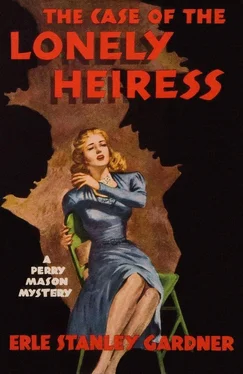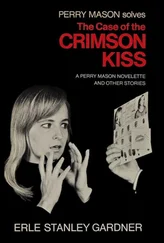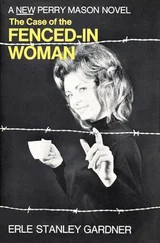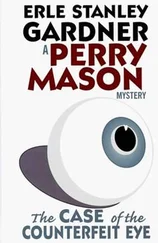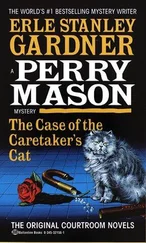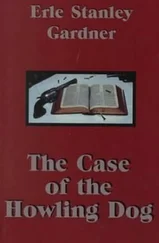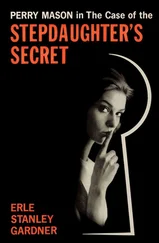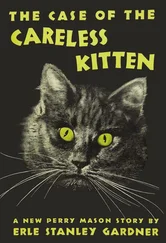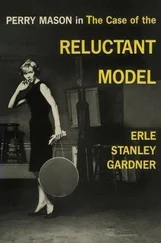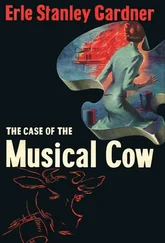“Now then,” Hanover said, “did the defendant make any statement at that time as to what she had done on that day with reference to being in the apartment of Rose Keeling?”
“She certainly did. She said she went to see Rose Keeling, that Rose Keeling was dead, that the defendant went to the telephone and called Perry Mason and that she was responsible for Perry Mason being there. She admitted that she was there in Rose Keeling’s apartment right about the time the murder was committed and that she had got in there with a key Rose Keeling had given her.”
“Cross-examine!” Hanover said triumphantly.
“The defendant admitted to you that she was in the apartment at about the time the murder was committed?”
“Well, she said she was there and it was about the time the murder was committed, because the police got there very shortly after Rose Keeling had been killed.”
“But she didn’t tell you that she was there at the time the murder was committed?”
“Well, not in so many words.”
“Or at about the time the murder was committed?”
“Not in so many words.”
“Or that she knew anything about the murder?”
“Not in so many words.”
“And did she tell you she entered the apartment with a key?”
“She said she had a key to the flat.”
“But did she tell you that she used it?”
“Not in so many words.”
“Didn’t she say she found the door open or slightly ajar?”
“Well, she may have put across some idea like that, but she had the key and...”
“What did she tell you?”
“I think she said she found the door open, but she had the key.”
“Thank you,” Mason said with sarcastic exaggeration of politeness. “That’s all, Sergeant Holcomb. Thank you for being such a fair and impartial witness.”
Sergeant Holcomb heaved himself to his feet, sneered at Mason and lumbered down off the witness stand.
“Now we’ll recall Lieutenant Tragg,” Hanover said. “Just take the stand again, Lieutenant.”
Tragg returned to the witness stand.
Hanover’s voice had an edge of triumphant power. “Now, Lieutenant, when you arrived at the apartment of Rose Keeling, what did you find specifically?”
“I found a house of the type known as a four-flat house,” Lieutenant Tragg said. “The flat which had been occupied by Rose Keeling was that on the second story on the south side.”
“I’ll show you a map and some photographs and ask you if you can identify these.”
“That’s right,” Tragg said. “This is a photograph of the four-flat house. This diagram is a map showing the layout of the apartment where the body was found. The location of the various rooms is shown on this map and the places marked here showing the approximate position of the body. Now this photograph is one that shows the bedroom and the body. This one shows the interior of the bathroom. This one shows the interior of the living room. This one shows the bedroom from another view. This is a close-up of the body. I can identify all of these maps and photographs as showing the things which I have mentioned. In other words, they’re true representations.”
“I ask that these be marked with appropriate numbers and be received in evidence,” Hanover said.
“No objection,” Mason said. “Let’s just get the records straight.”
The court clerk stamped the various exhibits, giving them appropriate numbers.
Hanover said, “Now, Lieutenant Tragg, calling your attention to the photograph, People’s Exhibit Number Four, I indicate two suitcases.”
“Yes, sir.”
“Did you notice those two suitcases when you first entered the flat?”
“I did, yes, sir.”
“What was in those suitcases, if anything?”
“Clothes,” Tragg said, and added quite casually, “she’d been packing up at the time she was killed.”
“Oh, indeed!” Hanover said, and added parenthetically, “Taking a trip?”
“She was packing up for a long trip, all right,” Lieutenant Tragg said. “She hadn’t finished packing when she was killed.”
“I see. And over here in the photograph of the living room there’s a telephone shown in the picture.”
“That’s right.”
“Now what did you do with that telephone, if anything?”
“Well, we dusted it pretty carefully for fingerprints.”
“And did you find any?”
“Fingerprints of only one person,” Tragg said. “Those of Mr. Perry Mason, attorney for the defendant.”
Judge Osborn leaned forward. “What’s that?” he said.
“Just the fingerprints of one person. Perry Mason’s fingerprints are on it.”
“No other fingerprints at all?”
“No.”
“Have you asked any explanation of the?... Well, go ahead, Mr. Hanover.”
Hanover said smilingly, “I was coming to that, Your Honor. Now, Lieutenant Tragg, just what happened when you arrived at the apartment?”
“Well, when we first got there to that flat,” Tragg said, “we were answering a call which had been put in by Mr. Perry Mason. We found Mr. Perry Mason and his secretary, Miss Street.”
“Did you have any conversation with them?”
“With Mr. Mason, yes. He told me that he’d found the door open and had walked in, and that he’d found the body and had telephoned police headquarters. He said he’d also telephoned Marilyn Marlow, his client.”
“Did he say anything to you about Miss Marlow having been at the flat?”
“No. Definitely not.”
Judge Osborn frowned ominously.
“Now, did the defendant subsequently make any statements to you as to how she happened to be at this flat?”
“Yes, she said she had an appointment to play tennis with Rose Keeling.”
“I notice in this photograph of the bedroom, there are tennis shoes, a tennis racket, and a container holding tennis balls.”
“That’s right. I noticed those particularly.”
“Did you have any conversation with the defendant concerning them?”
“Yes.”
“What was it?”
“I kept accusing the defendant of putting those things out after she had murdered Rose Keeling, putting them out so as to give a prop to her story about the tennis game.”
“And what did she say?”
“She would never admit that she’d done it.”
“Did the defendant ever offer you any explanation as to how it happened that Rose Keeling would extend an invitation to play tennis at a time when Miss Keeling was quite evidently hurriedly packing to get out of town as fast as she could?”
“No explanation,” Tragg said, and grinned.
“Now, did you have any conversation about a letter she had received from Rose Keeling?”
“That’s right.”
“What about it?”
“She said she’d destroyed it.”
“I now hand you what purports to be a carbon copy of a letter written in long hand addressed to Marilyn Marlow and bearing the signature of Rose Keeling and ask you if you’ve ever seen that carbon copy before.”
Mason said, “I submit, Your Honor, this certainly falls far short of an identification.”
“Marilyn Marlow destroyed the letter. We’re entitled to use the carbon copy,” Hanover said.
“Certainly you are,” Mason said, “provided you establish two things. One of them is that the original has been destroyed or not available, and, secondly, that this is a carbon copy of that original.”
Hanover said, “In view of this technical objection, Your Honor, it will be necessary for me to call other witnesses whom I have not planned to put on the stand. I think there can be no question but what this is a true carbon copy. It would expedite matters if I did not have to call these other witnesses.”
Mason said, “You have what purports to be a carbon copy of a letter. If you want to introduce it, you’ll have to show that it is a carbon copy. You’ll have to show that it is in the handwriting of the person who purported to sign that letter, and you have to go farther and prove that the letter of which this purports to be a carbon copy was received by the defendant.”
Читать дальше
